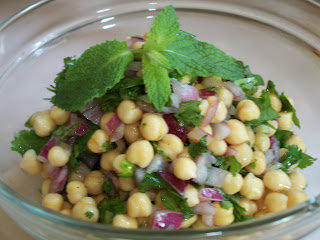
The following recipe takes about the same amount of time to prepare as the frying version but minus the calories and fat.Hope you enjoy them as much as I did.
Yield:18 felafel balls
Ingredients:
2 Tbsp. olive oil
1-14 oz. canned fava or lima beans, rinsed well and drained
2-14oz. canned low-sodium chick peas (garbanzos), rinsed well and drained
6 Tbsp. fresh mint leaves, finely chopped
2 Tbsp. fresh cilantro leaves, finely chopped
4 garlic cloves, peeled, minced
1/2 tsp. ground cumin
2 tsp. whole coriander seedsfinely grated zest and juice of 1 lemon
2 tsp. baking powder
1/4 c chickpea or regular flour
1 tsp. salt
1/2 tsp. freshly ground black pepper
1/2 c sesame seeds
1. Preheat oven to 350F. Oil a large baking dish with the olive oil. Set aside.
2.Combine all the ingredients together except the sesame seeds in a food processor or blender.Process until well combined.
3.Form the felafel mix into 2 Tbsp. sized balls or patties.
4.Place the sesame seeds on a dish.Roll the felafel balls or patties into the sesame seeds fully coating them.
5.Place the felafels in the oiled baking dish and bake for 30 minutes.Serve with sliced tomatoes, romaine lettuce, and spreadable feta.













































